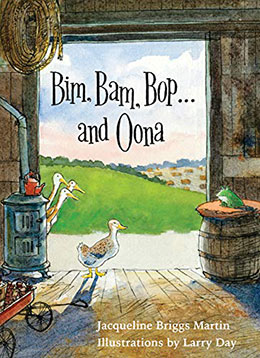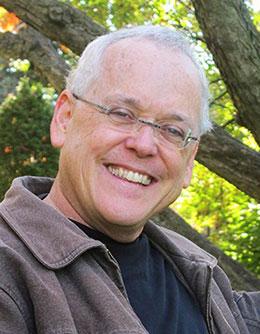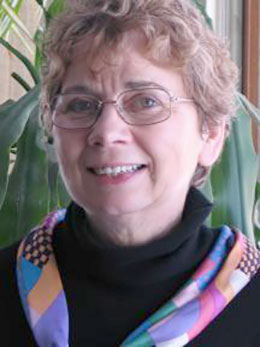 Poor Oona — she’s always the last duck to the pond…. But then her frog friend Roy reminds her: you’re good with gizmos… And so Oona the duck goes to work in the barn on her gizmos, pouring her creative and determined self into getting to the pond before the faster ducks. Along the way, she learns there is more to life than just being fast and getting somewhere first.
Poor Oona — she’s always the last duck to the pond…. But then her frog friend Roy reminds her: you’re good with gizmos… And so Oona the duck goes to work in the barn on her gizmos, pouring her creative and determined self into getting to the pond before the faster ducks. Along the way, she learns there is more to life than just being fast and getting somewhere first.
Bim, Bam, Bop … and Oona by Jacqueline Briggs Martin and Larry Day (illustrator) will be on a bookshelf near you soon. Until then, Bookology brings you a look behind the scenes of this picture book collaboration….
Bookology: How did Bim, Bam, Bop … and Oona come to be?
Jackie: I wrote this book a few years ago, sent it out, revised, sent it out again, revised again, etc. And no publisher quite wanted it. So I put it in a drawer. Then two to three years ago, in December, I got it out of the drawer and read it. Surprise: I liked it and made it a goal of the next year to find a publisher. I decided to read it at Hamline [MFA in Writing for Children and Young Adults] in the upcoming January [residency]. My reading night was during Alumni weekend. Larry happened to be at the residency with Miriam Busch, his wife [and an alumnus], and he heard it. He came up to me after the reading and said he’d love to illustrate it. I said if I found a publisher, I would remember that. When Erik Anderson at the University of Minnesota Press offered a contract, he asked if I had illustrators in mind. I told him Larry Day would be interested. He asked for a sample. When Larry sent his sample, we all knew he was the one. And we were right!

Larry: Jackie is spot on. Sitting in the audience as an observer listening to the faculty reading their manuscripts is always a unique event. When it got to Jackie’s turn I was hooked. I felt a real connection with her script. I loved the ingenuity and determination of this duck named Oona. While Jackie was reading, she had a series of slides of runner ducks projected on the screen behind her. I was sketching from the slides. After her reading, Miriam nudged me to approach Jackie.
I’m a huge advocate of collaboration and choosing who to work with. (I wouldn’t collaborate with my Aunt Mary. May she rest in peace.) I really appreciate working with pros like Jackie, Erik, and Miriam. Jackie never flinched at revising her own copy. In one of my spreads I changed Oona colliding with the clothesline and falling into the basket of clothes. After seeing the art, Jackie revised her copy to read,”…and Oona, who moped toward the barn, tripped into a tumble, and conked herself with an idea…” Erik, who put up with my own constant and numerous revisions, offered the kind of enthusiastic support illustrators dream of. And Miriam, who sees when the visuals fill in the story, offered many suggestions throughout the book, helping with critical pacing and page turns.
Bookology: This book is published by the University of Minnesota Press. You are an Iowa writer and Illinois artist. Talk to us about the sense of “place” in this book…and how the University of Minnesota Press came to be interested in it.

Jackie: The University of Minnesota is interested in publishing books with a Midwestern angle, I think, and the books should have appeal for those outside the Midwest. Larry has made the landscape a Midwestern landscape, but the issues are universal. Where does a duck fit? How does a duck fit? How do we find our true talents?
Larry: I was told that the UMP had a somewhat loose guideline to keep their books to an upper Midwest story theme. I guess I had that connection, since I was born and raised in a small farming community in central Illinois. Even though central Illinois is flat as flat can be, I would accompany my father who hunted turkeys in the rolling hills of northern Missouri. He hunted while I sketched the landscape. It was more like I was sketching while he was fast asleep in a blind as groups of turkeys casually strolled in front of him. I was also influenced by the poetic landscapes of the regionalist artist, Grant Wood.
Bookology: Jackie — there’s some very fun language here! The names of the ducks, “gizmos,” rhyming lines, ooo-hoolie-hoo! etc.
Jackie: I love words! When I can’t sleep at night, I go through the alphabet with assonant words. It doesn’t always help me to sleep but gives me pleasure. I do play with sounds, even when I am not writing. So I am often surprised by the words that get onto the page. Ooo-hoolie-hoo just sounds good to me. I do not know where it came from. Gizmo is also a favorite. I like the sound of z. We gave our son the nickname of Bizzy Bones. He was an active kid, but I really think it was the z sound that determined that nickname.
Bookology: Larry — there are two kinds of ducks in this story. Bim, Bam and Bop are runner ducks. Oona is not. A photograph of the two kinds of ducks would show their differences, certainly, but what went into your artistic rendering so that a child would understand the differences? Because this is a theme in the story — Bim, Bam, and Bop run. Oona waddles. How did that play out for you as an artist? What was your process in making them come alive on the page?
Larry: Oona is a rouen clair. I started out drawing her as a domestic duck: flat yellow beak, white body, wide yellow feet. I also tried drawing her as a mallard and as a combination of assorted ducks. Jackie suggested Oona needed to be more of a brownish farm duck, one that would contrast with the long-legged leaner athletic shape of the runner ducks. After many attempts at a variety of ducks, we picked a rouen clair. It was perfect! Oona would be a rouen clair! A rouen clair is a short, stocky, low-to-the-ground brownish duck with spots on her feathers that resemble freckles. The contrast of the shape of Bim, Bam, and Bop to Oona would add to the visual humor. Oona would have less of a stride and more of a waddle. A waddle is challenging to illustrate, but I delighted in this. I imagined the body language action of the waddling side-to-side motion as I drew.
Bookology: Tell us about Oona’s frog-friend Roy…. Was he always in the story?
Jackie: Roy was not always in the story. In some of the early, early drafts Oona did not have a friend. And she seemed lonely to me and a little bit sadder than I wanted her to be.
Larry: I love to illustrate the green blobby large-eyed shape of frogs. I love that Jackie added Roy. The story just wouldn’t be the same without him. The reader needs to see Roy offering encouragement to Oona when she needs it the most — a true friend. Everyone needs a little Roy in their lives.
Bookology:: What was the writer-artist process of creating Oona’s gizmos on the page? Some are briefly described in words, but all certainly have room for “artistic license.” How did the two of you work together (or not) on these creative gizmos for Oona?
Jackie: Larry gets total credit for the wonderful gizmos. Writers just say Ooo-hoolie-hoo, and illustrators like Larry have to do the work.
Larry: The very first pencil sketch I made of Oona was her flying in her basket. The problem with that sketch was that the gizmos attached to the basket were too simple and basic. Jackie suggested that we up the wackiness level of the gizmos. So, I needed to “think outside the basket,” so to speak.
I remembered spending the day at the Museum of Science and Industry in Chicago. There was a rather large, elaborate, bicycle-like contraption on display. It was created by the British cartoonist Rowland Emett. His work played a big part influencing the art for Oona’s workshop and her flying contraption. Emett’s work gave me the confidence I needed to up the gizmo level. Sometimes, no matter what level you are at, you need that extra push.
Bookology: Oona doesn’t feel “as big as a duck should.” She doesn’t feel “as bouncy as a duck should.” But she’s very creative…. Determined and clever, as well. Where did this character come from? Why these traits mixed with her self-doubt? What do you hope kids take away from this story?
Jackie: I really just want them to enjoy the story, love Oona enough that they think about her, take her with them. My biggest want is that she becomes part of the furniture of their minds. And then they may have various takeaways. She’ll just be there as one more character that they know. I’d love for kids to experiment with gizmos, for them to be so joyous they can’t resist saying Ooo-hoolie-hoo, for them to become more interested in ducks, and for them to remember Oona and try one more time.
Larry: I love everything Jackie says. I too, hope this book sparks readers to connect with their own sense of determination and creativity. I give credit to our editor, Erik Anderson, for his insight and enthusiastic appreciation of Oona. Both Erik and I were Oonas as young kids. Short and slow. Always picked last on school sports teams. Everyone else whizzing past us on the school ground. Always the underduck. But when it came to creativity, we excelled. I can’t predict what readers will take away from Oona, but maybe if even a short stocky brownish farm duck can manage something extraordinary, so can they.
Bookology: Thanks to you both for taking us behind the scenes of Bim, Bam, Bop…and Oona. Thank you for bringing this book to the world!

Thanks, Melanie, for giving so much time and space to Oona. Oo-hoolie-hoo!